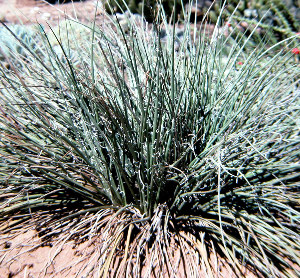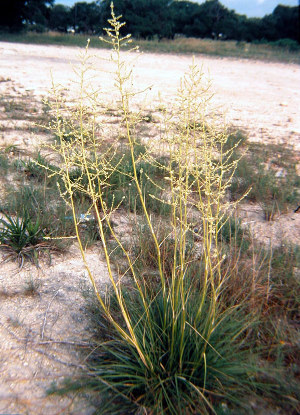Texas Beargrass, Sacahuiste
Nolina texana Wats.; Nolina spp.
Liliacae (Lily Family)
Beargrass resembles a very coarse grass, growing from a woody caudex or central stem at or just below the ground surface. The leaves are tough, very long, and very narrow and its overall apperance is similar to sotol, yet with much narrower and thornless leaves. Its tough and flexible fiber was used for weaving and basketry, while other parts of the plant were used for soap and medicine.
Although there are about 30 species of Nolina in the southwestern United States and Mexico, by far the most common one along the western Edwards Plateau is Nolina texana. It grows from the Rio Grande Plains and central Edwards Plateau to El Paso County. However, Nolina micrantha grows in the Guadalupe Mountains, Nolina erumpens from Hudspeth to Terrell Counties, and Nolina microcarpa From the North Hueco Mountains to El Paso County and westward into Arizona (Powell 1998).
Archeological occurrence. Beargrass was recovered from Analysis Unit 5, a Middle Archaic context at Hinds Cave (Dering 1979). Nolina sp. has been identified in basketry fragments from Middle and Late Archaic contexts at Hinds Cave (Andrews and Adovasio 1980). It was recovered from Murrah Cave in the Lower Pecos region (Holden 1937). Beargrass has also been recovered from archaeological sites throughout the greater desert Southwest (Bell and Castetter 1941).
Food; cooking utensils. I have not been able to locate direct evidence of beargrass being processed and consumed for food in Texas, and that includes either archeological or ethnohistoric evidence. However, observers have noted that some beargrass species in the greater Southwest and adjacent Mexico were processed in various ways and eaten, and this could very well have occurred in Texas.
The flowering stalks of Nolina microcarpa were harvested by the Western Apaches and cooked on open coals for half an hour, then peeled and eaten. Buskirk (1986) noted that the stalks were eaten when they reached a height of about 30 inches. This is very likely since the flowering stalks of yucca, sotol, and agave become far too fibrous to eat when they mature. Conversely, the stalks must reach a certain size before they can provide sufficient sustenance. The informant said that the cooked stalks tasted like a soft and sticky fruit. Likewise the Chiricahua and Mescalero roasted and ate the flower stalks (Castetter and Opler 1936).
The San Carlos Apache ate the fruits (Buskirk 1986). They also cooked and dried the stalks, storing them for later consumption. In southern California, the Cahuilla also baked the stalks in earth ovens (Bean and Saubel 1972). The Isleta ground the seeds into a meal and consumed them in a mush (Castetter 1935).
The Chiricahua and Mescalero Apache laid the leaves onto hot rocks to provide steam. (Castetter and Opler 1936). Groups also used the leaves to make drying mats for baked agave stems and banana yucca fruits, and they fashioned the broad leaf bases into spoons (Basehart 1960; Buskirk 1986).
Medicine. Beargrass was used by the Isleta to treat lung problems and rheumatism (Jones 1931). A decoction of the root was utilized in both instances, however, it is more likely that the reference is to the compressed stem.
Basketry. Evidence of the use of beargrass for weaving baskets is widespread. The long, narrow, flexible leaves are an ideal material for making baskets. In the twined basketry of Hinds Cave and other sites in the Lower Pecos region, beargrass was used in warps (the stationary part that the material is woven around) and in wefts (the part of the basket that is woven around the warp). And some coiled baskets have bundle foundations fashioned from beargrass as well (Andrews and Adovasio 1981; McGregor 1992). At Hinds Cave, these baskets were recovered primarily from Late Archaic (about 2000 years ago) contexts, however, McGregor (1992) notes that the basketry traditions of the area span at least 8000 years.
In fact, the tradition continued into historic times (and probably continues today). Across the Southwest many Native American groups utilized beargrass as a versatile foundation material for coiled basketry (Bell and Castetter 1941). The Pima, the Papago, and several Pueblo Indian groups used beargrass bundles specifically as foundation in coiled basketry in addition to using it in the lateral parts of baskets.
Other fiber uses. Among various Southwestern groups it was used as roofing thatch in areas where beargrass could be obtained in quantity. The Beargrass leaves were used as-is to tie objects together, and they were split and woven into cordage. General purpose mats were also constructed of beargrass, and the floors of tipis were covered with the material (Basehart 1960; Bell and Castetter 1941; Jones 1931).
Soap. As late as the 1940s beargrass stems were a preferred source of soap on the Fort Apache Reservation (Bell and Castetter 1941). The Western Apache considered beargrass to be the best source of soap available (Buskirk 1986).
References:
Andrews, Rhonda L. and James M. Adovasio
1980 Perishable Industries from Hinds Cave, Val Verde County, Texas. Ethnology Monographs Number 5. Department of Anthropology, University of Pittsburgh. Pittsburgh, Pennsylvania.
Basehart, Harry
1960 Mescalero Apache Subsistence Patterns and Socio-Political Organization. The University of New Mexico Mescalero-Chiricahua Land Claims Project Contract Research #290-154. University of New Mexico. Albuquerque.
Bean, Lowell J. and Katherine S. Saubel
1972 Temalpakh: Cahuilla Indian Knowledge and Usage of Plants. Malki Museum Press. Morongo Indian Reservation, Banning, California.
Bell, Willis H. and Edward Castetter
1941 The Utilization of Yucca, Sotol, and Beargrass by the Aborigines in the American Southwest. Ethnobiological Studies in the American Southwest. Vol. VII. University of New Mexico Bulletin, Biological Series 5(5).
Castetter, Edward F.
1935 Uncultivated Native Plants Used as Sources of Food. Ethnobiological Studies in the American Southwest. Vol. I. The University of New Mexico Bulletin, Biological Series 4(1). Albuquerque, New Mexico.
Castetter Edward F. and Morris Opler
1936 The Ethnobiology of the Chiricahua and Mescalero Apache. A. The Use of Plants for Foods, Beverages, and Narcotics. Ethnobiological Studies in the American Southwest. Vol. III. The University of New Mexico Bulletin, Biological Series 4(5). Albuquerque, New Mexico.
Dering, J. Philip
1979 Pollen and Plant Macrofossil Vegetation Record Recovered from Hinds Cave, Val Verde County, Texas. Unpublished Masters Thesis. Texas A&M University. College Station, Texas.
Fletcher, Henry Turney
1930 Notes on the Ethnobotany of Bee Cave Canyon. Bulletin of the West Texas Historical and Scientific Society 33:37-44.
Holden, William C.
1937 Excavation of Murrah Cave. Bulletin of the Texas Archeological and Paleontological Society 9:48-23.
Jones, Volney H.
1931 The Ethnobotany of the Isleta. Unpublished Masters thesis, University of New Mexico. Albuquerque, New Mexico.
McGregor, Roberta
1992 Prehistoric Basketry of the Lower Pecos, Texas. Monographs in World Archaeology 6. Prehistory Press. Madison, Wisconsin.
![]()

